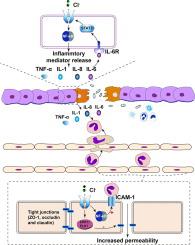Journal of Advanced Research ( IF 10.7 ) Pub Date : 2021-02-04 , DOI: 10.1016/j.jare.2021.01.013 Weiliang Bai 1 , Mei Liu 2 , Qinghuan Xiao 2

|
Background
Transmembrane protein 16A (TMEM16A) Ca2+-activated Cl− channels have diverse physiological functions, such as epithelial secretion of Cl− and fluid and sensation of pain. Recent studies have demonstrated that TMEM16A contributes to the pathogenesis of infectious and non-infectious inflammatory diseases. However, the role of TMEM16A in inflammation has not been clearly elucidated.
Aim of review
In this review, we aimed to provide comprehensive information regarding the roles of TMEM16A in inflammation by summarizing the mechanisms underlying TMEM16A expression and activation under inflammatory conditions, in addition to exploring the diverse inflammatory signaling pathways activated by TMEM16A. This review attempts to develop the idea that TMEM16A plays a diverse role in inflammatory processes and contributes to inflammatory diseases in a cellular environment-dependent manner.
Key scientific concepts of review
Multiple inflammatory mediators, including cytokines (e.g., interleukin (IL)-4, IL-13, IL-6), histamine, bradykinin, and ATP/UTP, as well as bacterial and viral infections, promote TMEM16A expression and/or activity under inflammatory conditions. In addition, TMEM16A activates diverse inflammatory signaling pathways, including the IP3R-mediated Ca2+ signaling pathway, the NF-κB signaling pathway, and the ERK signaling pathway, and contributes to the pathogenesis of many inflammatory diseases. These diseases include airway inflammatory diseases, lipopolysaccharide-induced intestinal epithelial barrier dysfunction, acute pancreatitis, and steatohepatitis. TMEM16A also plays multiple roles in inflammatory processes by increasing vascular permeability and leukocyte adhesion, promoting inflammatory cytokine release, and sensing inflammation-induced pain. Furthermore, TMEM16A plays its diverse pathological roles in different inflammatory diseases depending on the disease severity, proliferating status of the cells, and its interacting partners. We herein propose cellular environment-dependent mechanisms that explain the diverse roles of TMEM16A in inflammation.
中文翻译:

TMEM16A Ca2+ 激活的 Cl- 通道在炎症中的不同作用
背景
跨膜蛋白16A(TMEM16A)Ca 2+激活的Cl -通道具有多种生理功能,如上皮分泌Cl -和液体和疼痛感。最近的研究表明,TMEM16A 有助于感染性和非感染性炎症性疾病的发病机制。然而,TMEM16A 在炎症中的作用尚未明确阐明。
审查目的
在这篇综述中,我们旨在通过总结 TMEM16A 在炎症条件下表达和激活的机制,以及探索 TMEM16A 激活的多种炎症信号通路,提供有关 TMEM16A 在炎症中作用的全面信息。本综述试图提出 TMEM16A 在炎症过程中发挥多种作用并以细胞环境依赖性方式导致炎症性疾病的观点。
审查的关键科学概念
多种炎症介质,包括细胞因子(例如,白细胞介素 (IL)-4、IL-13、IL-6)、组胺、缓激肽和 ATP/UTP,以及细菌和病毒感染,促进 TMEM16A 的表达和/或活性炎症状况。此外,TMEM16A 激活多种炎症信号通路,包括 IP 3 R 介导的 Ca 2+信号通路、NF-κB 信号通路和 ERK 信号通路,参与多种炎症性疾病的发病机制。这些疾病包括气道炎性疾病、脂多糖诱导的肠上皮屏障功能障碍、急性胰腺炎和脂肪性肝炎。TMEM16A 还在炎症过程中发挥多种作用,通过增加血管通透性和白细胞粘附、促进炎症细胞因子释放和感知炎症引起的疼痛。此外,TMEM16A 在不同的炎症性疾病中发挥着不同的病理作用,这取决于疾病的严重程度、细胞的增殖状态及其相互作用的伙伴。我们在此提出了细胞环境依赖性机制来解释 TMEM16A 在炎症中的不同作用。



























 京公网安备 11010802027423号
京公网安备 11010802027423号